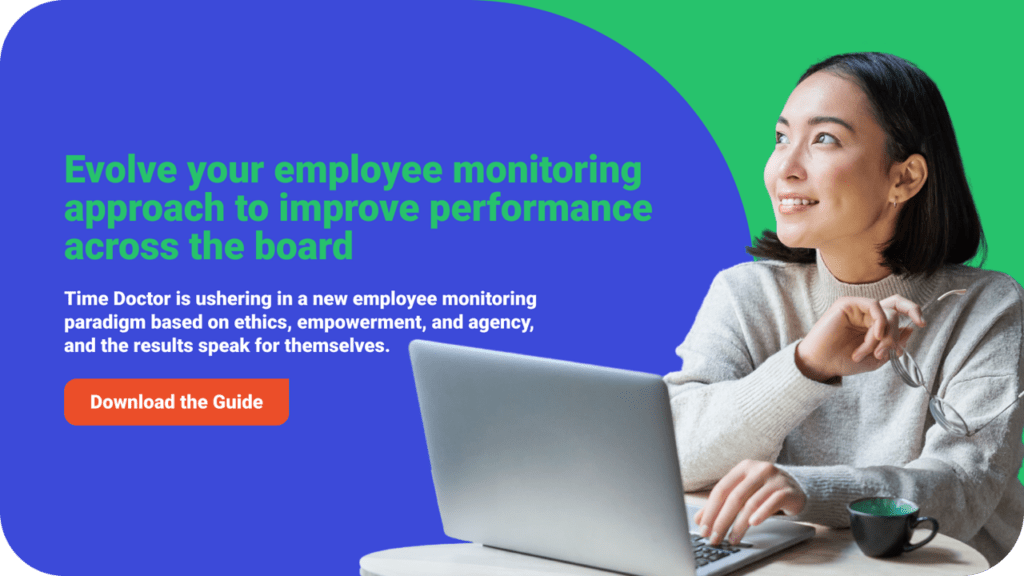For the last 40-50 years, forward-thinking organizational leaders have been working hard to reform top-down organizations into places where democracy and collaboration set the pace of progress. Employee empowerment has become non-negotiable.
However, one area that has been slow to transform is employee monitoring. It’s only since Time Doctor recognized the need for employee-friendly monitoring that things really started moving in the right direction.
Employee monitoring is overdue for a shake-up
Traditional employee monitoring approaches relied on methods that tended to be intrusive and micromanaging:
- Monitoring activity without telling workers
- Recording and monitoring intracompany communication
- Assessing performance on task-based metrics
- Docking pay based on blanket rules about productive time
- Penalizing or even terminating employees based on rigid metrics
This unfortunate legacy has less to do with employee monitoring per se and more to do with management philosophies rooted in compliance and hierarchy.
Monitoring tools that extend from an ethical, improvement-focused management approach are a powerful force for good. They instill a sense of agency and help employees master their own productivity.
Monitoring also helps managers identify areas where they can provide support that improves the employee experience to move the needle on organizational growth.
The difference between success and resistance is how it’s managed.
Empowerment, not enforcement
If there’s any doubt that employees’ needs have evolved, recent surveys and studies on employee satisfaction do away with it.
- 77% of employees are not engaged at work, and 18% are actively disengaged (source)
- 60% of knowledge workers say they are more productive when given greater autonomy (source)
- 72% would leave their job if they felt underutilized or understimulated (source)
- 66% of people leave jobs due to engagement and culture or work-life balance issues, while only 20% leave because of low pay (source)
People want agency. They want to feel valued as part of a team. They want to know that their efforts are contributing to building something worthwhile. Managers who facilitate this fundamental shift from routine work to purpose-driven productivity will find themselves managing a more engaged, efficient and innovative team.
This is the driving force behind the evolution from traditional (surveillance and enforcement) monitoring to modern (improvement and empowerment) monitoring, and it carries through to the functions and features we see as essential in software that supports employee monitoring ethics.

Fundamental purpose
Traditional monitoring is used to control and supervise employees in organizations, ensuring rules are followed and short-term production targets are ticked off.
Improvement-focused monitoring is used to identify areas for improvement, give employees agency and support them to excel.
Functional differences
Traditional monitoring is often intrusive and secretive, characterized by stringent oversight, rigid output metrics and close monitoring of employees’ activities without regard for personal context.
Improvement-focused monitoring is transparent, collaborative and purpose-driven, positioning employees as partners in their own development and using data to link individual contributions to organizational success.
Features and impact
Traditional monitoring prioritizes compliance above excellence, leading to decreased efficiency and a stark lack of creativity.
Improvement-focused monitoring involves employees in data gathering and reporting processes, giving them ownership over their personal development and accountability over their time.
Putting the two side-by-side, it’s not hard to see where traditional monitoring has failed to adapt to the demands of organizations and employees today.
Modern solutions for modern teams
Work has changed. We’re not only talking about the transition to remote and hybrid working in the knowledge economy, although that is a big contributor. Conventional work has also changed; whether you run a manufacturing plant or call center, the way managers build and lead teams looks fundamentally different to a decade ago.
Change is always tricky to manage. Especially when it’s thrust upon you by, let’s say, a global pandemic that makes in-person interactions unsafe for workers.
Although remote workers are significantly more productive than in-office teams (when given the right support), the data suggests managers might be conflicted.
- 87% of employees feel more productive at home, but 85% of managers don’t have confidence in their people to work unsupervised (Microsoft)
- 76% of people said flexibility in work location would be a deciding factor for their next job, while 54% of companies have seen candidates turn down jobs due to a lack of flexibility (Owl Labs / Forbes)
- 60% of companies believe they will lose good people if they don’t offer greater flexibility, yet 42% of American workers have no option to work remotely (Forbes & McKinsey)
While it’s easy to look at these figures and see conflict between disgruntled workers and unsympathetic organizations, we believe there’s more going on here. On both sides of the relationship, people’s routines and methods were turned upside-down faster than anyone could have predicted.
What we’re seeing is the next big paradigm shift, the fourth Industrial Revolution. When it all washes out, decentralized work and asynchronous collaboration will be the rule, not the exception. Whether that takes one, five or 15 years is still unclear, but the train has left the station and we’re very much aboard.
Employee monitoring software is building trust in times of change
The lack of direct oversight inherent in remote work makes many managers nervous. At times, for good reason. What Microsoft calls “productivity paranoia” could be arising from “productivity theatre” – or it could simply be paranoia.
There’s only one way to know for sure.
Before the pandemic, an estimated 30% of companies used employee monitoring software. Now that estimate is closer to 80%, with some industries reporting 96% adoption. In most cases (79%), managers check workday data to understand how employees spend their time.
Monitoring tools bridge the gap between team members and managers by providing visible, verifiable proof of productivity. This bridge isn’t just important for remote teams, either. In-office teams like Boring Commerce realize significant efficiency gains with a holistic, centralized overview of project performance.
The most important thing – and we’ll repeat this a few times because it really is that important – is to implement employee-friendly monitoring in a transparent and collaborative way.
Splitting hairs? Hardly.
When leaders clearly communicate the purpose and function of employee monitoring software and give employees opportunities for input, the implementation goes much more smoothly.
It’s not necessarily the fact they’re monitored that bothers employees but how it’s done.
It might sound like splitting hairs. But we’re really talking about a fundamental shake-up of employee monitoring that starts with clearly identifying the purpose for monitoring and permeates through to choosing software that upholds employee monitoring ethics.
According to Accenture, 92% of workers would be open to employee monitoring if it improved their performance or well-being.
Nearly three-quarters (73%) also said they would want access to their own work-related data and would even take it when they left the job.
- 77% of US employees would be fine with employee monitoring if the company was transparent and let them know upfront (source)
- 64% agreed that monitoring devices for security reasons is perfectly fine – again, provided the employer is transparent (source)
- 62% would be comfortable with monitoring on work-issued devices if the data was anonymized, and 36% feel the same about personal devices (source)
- 50% of workers were comfortable with monitoring when the employer explained the reasons for it (source)
Far from doing away with oversight, managers and employees alike should harness the potential of ethical employee monitoring software to build trust and work transparently.
Employee-friendly monitoring: How it’s done and real-life success stories
Although there’s no universal playbook for employee monitoring ethics, there are common steps that every organization should follow.
The first and most important step is, you guessed it, being transparent and collaborative from the get-go.
10 steps to evolve your employee monitoring approach

- Assess current practices
Conduct an internal audit of current monitoring methods and attitudes. Identify the surveillance-heavy processes that need to evolve and try to measure their impact on employee well-being.
- Set clear goals
Organizational leaders, managers and employees work together to define goals for the implementation. Focus on objectives that empower employees and link to organizational goals, such as replacing output metrics with long-term productivity trends.
- Choose the right tools
Select employee-friendly monitoring tools that align with your new improvement-focused approach. Look for systems that allow active participation and give employees tools to be accountable for their time.
- Communicate often and honestly
Maintain open and transparent communication from the start. Explain the reasons for the change, outline expected benefits for employees and the organization, and maintain a proactive update system. Oh, and be ready for questions.
- Legal and regulatory compliance
Ensure the new monitoring approach complies with relevant laws and regulations, especially data protection and employees’ rights to privacy. The applicable laws and notification requirements vary in each country, so global organizations and companies hiring internationally in particular need to pay attention.
- Pilot program
Start by inviting a select group of employees to trial the employee monitoring software. Gather feedback and fine-tune the approach based on their experiences. Part of this process involves looking at the feedback ecosystem around the software to ensure old-school management methods aren’t tainting the process.
- Adapt and scale
Tweak the monitoring approach as it’s rolled out across the business to ensure it doesn’t become rigid or irrelevant. Just as employee monitoring gives workers agency, managers should have the autonomy to adapt the process to their team’s requirements.
- Provide resources
Ensure employees have access to the necessary training, tools and support to thrive in the new monitoring environment. Employee monitoring offers exceptional clarity into the tasks employees struggle with, which is data you can use to lift up your team.
- Monitoring guidelines
Develop clear guidelines and expectations for employees regarding self-assessment, goal-setting, and collaboration. Encourage regular check-ins and progress reviews. At every opportunity, use productivity data as the basis for these conversations, giving employees a reference point for their progress.
- Continuous improvement
If there’s one constant in the new era of work, it’s change. Continuously assess and refine the new monitoring process as things change to ensure you’re not missing part of the employee experience picture. Solicit employee feedback and make adjustments to address any challenges or issues.
Employee monitoring ethics in action
Time Doctor has been waving the flag for employee-friendly monitoring for over a decade. Our 200,000 active users in 50+ countries are eager to evolve from traditional top-down management into a new era of democratic and transparent work.
Of course, a lot has changed in the last 12 years. This is why it’s particularly interesting to see how Time Doctor users navigated unprecedented change on a foundation of reliable productivity data.
Take Eufonie, for example. When the Madagascar-based BPO transitioned to 100% remote working in 2020, management was naturally concerned about accountability and output. But rather than tighten the reins, CEO Johan le Bail leant into the change.
He and his team used Time Doctor to gather workday insights that would help them guide decision-making. What they gained in workday data was visibility over the workforce, proof of productivity, and the ability to help employees who could no longer ask a colleague at the next desk for help.
“Time Doctor is a great tool to help train and verify what can be improved in our day to day processes. We can understand what is easier and harder for employees to do, which you can’t get in-office.”
Johan le Bail, Eufonie
Eufonie is just one example of a leader embracing change when resisting would have been so easy.
Comparakeet founder Janus Jarapa took a different approach to building trust in his team by turning a potential disciplinary situation into a learning opportunity. When Janus and the other founders noticed an employee adjusting timesheets by ~20 hours per week, they took a closer look at the person’s workday data.
Pretty soon, they realized that the person was doing the work, but they were regularly distracted. While working with the employee on accountability and time management, the founders – who are spread around the world – saw an opportunity to lead by example.
“We also monitor each other with Time Doctor to ensure everyone is contributing an equal amount of time. We operate our business remotely. Of the founders, one is in San Francisco and one is in Israel. It’s very cool and Time Doctor acts as a productive force for any remote team.”
Janus Jarapa, Comparakeet
And if you’re wondering whether we walk the talk, the answer is an enthusiastic “yes!”. As busy as they are releasing integrations and improving features, Time Doctor’s engineering team has a great work-life balance. That’s because our well-being dashboard catches the early signs of overwork and alerts the team’s manager, Geoff Ainsworth, so he can support his team.
People don’t always feel comfortable speaking up on work-life balance issues. Time Doctor’s work-life balance dashboard speaks up for them, enabling managers to intervene and balance the scales before their best people burn out.
“The dashboard tells me in real-time who may be at risk of burnout by highlighting those working late, working on weekends, and generally building unhealthy habits which may eventually lead to turnover.
It takes seconds to review and generates results that we can use to help with employee retention and productivity.”
Geoff Ainsworth, Time Doctor
Your practical guide to achieving peace of mind with ethical employee monitoring
Change takes time. But evolving your organization’s employee monitoring approach is well worth it, and you can rest assured that an engaged and empowered workforce will deliver ROI.
We’ve created a guide to improvement-inspired management and employee-friendly monitoring to help modern managers evolve their approach gradually and effectively. The goal is an evolution that sticks, which means moving at a pace that makes sense for your organization.
Productivity and Peace of Mind: A Guide to Improvement-Focused Employee Monitoring is completely free and includes:
- A deep-dive into improvement-focused management
- The costs of staying with a compliance mindset
- How technology has changed employee monitoring ethics
- Practical steps to evolve employee monitoring
- Using productivity data to build trust
Check out the guide or reach out to one of our productivity specialists for a personalized look at Time Doctor’s ethical and employee-friendly productivity analytics.

Andy is a technology & marketing leader who has delivered award-winning and world-first experiences.


